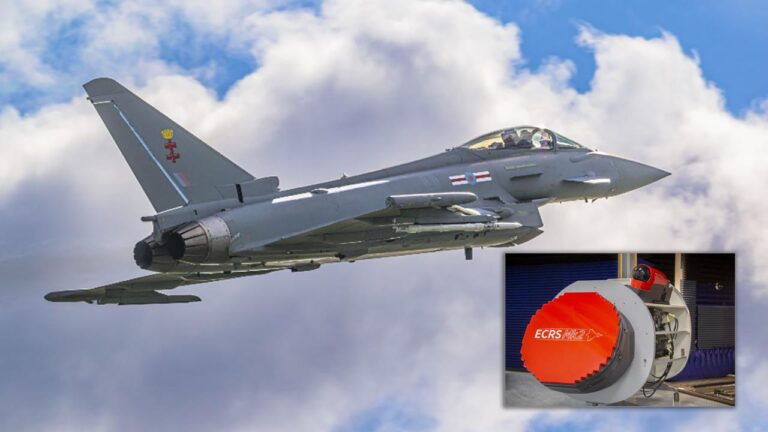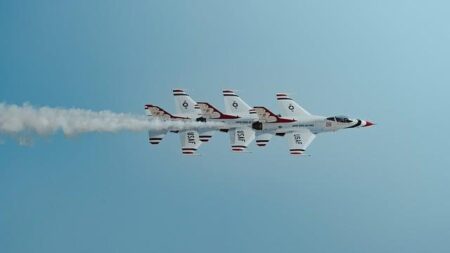The United Kingdom is making significant strides in advancing its defense technology with the development of the new ECRS Mk2 Active Electronically Scanned Array (AESA) radars, set to equip the Royal Air Force’s Eurofighter Typhoons. This cutting-edge radar system promises enhanced detection capabilities, improved situational awareness, and greater operational flexibility for British air combat units. As the Ministry of Defence pushes forward with modernizing its fleet, the introduction of the ECRS Mk2 radar marks a pivotal upgrade, reinforcing the Eurofighter’s role as a cornerstone of the UK’s air defense strategy.
United Kingdom Accelerates Development of ECRS Mk2 AESA Radars for Eurofighter Fleet
The United Kingdom has significantly ramped up production efforts of the advanced ECRS Mk2 Active Electronically Scanned Array (AESA) radars, designed to enhance the operational capabilities of the Royal Air Force’s Eurofighter Typhoon fleet. The next-generation radar system promises substantial improvements in target detection, tracking range, and resistance to electronic countermeasures, ensuring the Typhoon remains competitive in modern aerial warfare environments. This development aligns with broader defense modernization efforts, consolidating the UK’s position as a leader in avionics technology.
Key features of the ECRS Mk2 radar include:
- Multi-target tracking: Simultaneous engagement of numerous airborne and ground targets.
- Improved situational awareness: Enhanced radar imaging with reduced clutter interference.
- Electronic attack support: Integrated electronic warfare capabilities to disrupt adversary sensors.
With production rates accelerating, the Royal Air Force aims to complete fleet-wide integration by the late 2020s. The table below outlines the projected production milestones compared to previous radar systems:
| Radar Model | First Deployment | Production Rate (units/year) | Projected Fleet Integration |
|---|---|---|---|
| ECRS Mk1 | 2018 | 12 | 2025 |
| ECRS Mk2 | 2023 | 20 | 2029 |
Enhanced Capabilities and Tactical Advantages Offered by the New Radar Systems
The integration of the new ECRS Mk2 AESA radar into the Royal Air Force’s Eurofighter fleet marks a significant leap forward in aerial combat technology. These radars offer superior detection ranges, enhanced electronic warfare capabilities, and robust resistance to jamming. Operators can now identify and track multiple targets simultaneously with unprecedented precision, allowing for swift and informed tactical decisions during complex missions. Furthermore, the radar’s agility in scanning capability reduces target acquisition time, drastically improving situational awareness in contested environments.
Beyond raw detection power, the ECRS Mk2 AESA system brings an array of tactical advantages:
- Multi-target tracking: Engages several aerial threats concurrently with pinpoint accuracy.
- Passive electronic scanning: Enables quick directional shifts without mechanical delays, reducing radar signature.
- Enhanced ground mapping: Facilitates dynamic terrain-following missions and precision strikes.
- Improved signal processing: Augments threat identification and reduces false alarms.
| Capability | Description | Operational Benefit |
|---|---|---|
| Detection Range | >150 km for fighter-sized targets | Early threat engagement |
| Tracking Capacity | Up to 50 airborne targets | Enhanced multi-threat response |
| Electronic Countermeasures | Adaptive anti-jamming tech | Maintains operation in hostile EW environments |
| Scan Agility | Millisecond beam steering | Rapid situational updates |
Strategic Recommendations for Integrating ECRS Mk2 Radars into Royal Air Force Operations
To maximize the operational impact of the ECRS Mk2 AESA radars, it is essential that the Royal Air Force adopts a phased integration strategy emphasizing system interoperability and network-centric warfare capabilities. Prioritizing software updates that align sensor data sharing across multiple platforms will ensure that Eurofighter pilots receive real-time situational awareness, enhancing mission adaptability. Additionally, implementing comprehensive training programs focused on exploiting the radar’s advanced Electronic Scanning and multi-target tracking features will accelerate crew proficiency and reduce the learning curve associated with cutting-edge avionics.
Furthermore, the strategic deployment of ECRS Mk2 equipped Eurofighters must be paired with upgraded ground control infrastructure to fully leverage data fusion and command-and-control enhancements. This approach supports a more cohesive tactical ecosystem, essential for contested airspace environments. Consider the following action points for seamless integration:
- Incremental hardware roll-out: Prioritize frontline squadrons based on operational tempo and mission profiles.
- Joint force exercises: Regular interoperability drills with NATO allies to synchronize radar capabilities and sharing protocols.
- Cybersecurity strengthening: Embed advanced protection measures to safeguard radar software and communication links.
| Integration Aspect | Recommended Action |
|---|---|
| Training | Simulators & live exercises focused on AESA functionalities |
| Maintenance | Establish rapid-response technical teams |
| Data Sharing | Upgrade communication networks for low latency |
To Conclude
As the United Kingdom accelerates the development of the ECRS Mk2 AESA radar system, the Royal Air Force’s Eurofighter fleet stands poised to gain a significant edge in aerial combat capabilities. This advancement not only underscores the UK’s commitment to maintaining technological superiority in defense but also reinforces its strategic role within NATO and beyond. With enhanced detection, tracking, and electronic warfare features, the Mk2 radar is set to become a cornerstone of the RAF’s modernization efforts, ensuring readiness for the challenges of future air operations. Further updates on the program’s progress will be closely watched by defense analysts and international partners alike.




